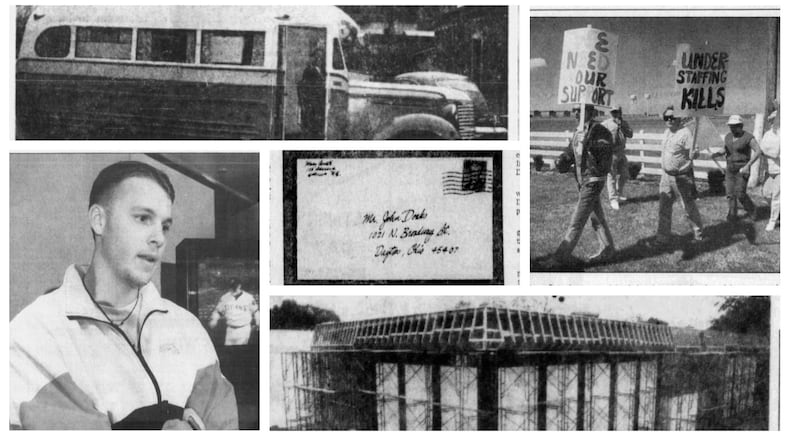Here’s a look at some stories happening the week of June 4-10.
June 5, 1949: Daytonian ready for summer tour in school bus converted into home
Converting buses into mobile homes is fairly common these days, but in 1949 it was frontpage news.
Roman Farmer had converted an old school bus into what he called “Blunderbus I.”
The Blunderbus had beds for four, sofa seating, a dinette table, cupboards, a stove, sink, refrigerator and and other items “necessary for comfortable, relatively carefree living.”
An engineer with Dayton Malleable Iron Co., Farmer said the principals he used in building the Blunderbus “may well revolutionize the whole house-trailer industry.”
Farmer had plans to take the Blunderbus on fishing trips and a three-week vacation with his two daughters and brother to places including Washington D.C. New York and Canada.
June 5, 1956: Dayton policeman friend to city’s lost children
In 1956, the Dayton police department was receiving about 100 missing persons reports involving children per year. More than half were between 6 and 8.
It was important to the police chief to get the word out to children that “any officer can be counted on as a certain and helpful friend.”
Most lost children reports were coming after a downtown parade or celebration. “We always come up with at least three or four lost children then,” said one officer.
When children were found, they were brought to the police station for the “ice cream cone treatment” as their information was broadcast out to other police units.
The police chief said that a child is usually returned to their parents in a short time.
June 6, 1963: ZIP to give mail deliveries zip
The national system of using ZIP codes on mail was set to begin July 1, 1963 and this news article was an explanation of how it was going to work and how people should start addressing envelopes.
The ZIP plan was considered the most modern mail delivery system ever devised. It was aimed at speeding up delivery between cities.
ZIP stands for Zone Improvement Plan. Dayton was assigned the zone number of 454. The two numbers that followed were the personal sectional zone numbers.
The ZIP code was go after the state on the envelope. Previously, the post office code went between the city and state.
Cities surrounding Dayton were assigned the prefix 455 while individual post offices outside of Dayton would use 453. Because Springfield was services through Dayton, it’s prefix was also 455.
June 4, 1972: Four students barred from Centerville Commencement
Four Centerville students were not allowed to attend their graduation ceremony as punishment for their end-of-school-year pranks.
One student threw a firecracker onto the football field, two others lit a smoke bomb in a school building, and another hauled trash cans, a sled and some other things into the parking lot.
“In my 10 years as a principal, I have never seen anything of the nature of what goes on here, " said principal Carl Adams.
Greg Grubish, captain of the football team, didn’t see it that way.
“We were up at school one night and decided to do something because it was the end of school,” he said.
June 4, 1980: Area developer constructing ‘coffee cup building’
The area’s first and perhaps the nation’s first “coffee cup building” was nearing completion in 1980 at the corner of Woodman Drive and Eastman Avenue in Mad River Twp.
It was dubbed the coffee cup building because it was made of polyurethane, which was similar to the Styrofoam commonly used for coffee cups and picnic coolers in that era.
The entire exterior of the two-story structure was constructed using plastic foam panels. The idea was that it would keep the inside warm in the winter and cool in the summer.
“I don’t know of another office building in the country that has been built with this system,” said developer Marty Nizny, who believed it could be a prototype for buildings in the 1990s.
June 5, 1988: Prison guards picket Lebanon Correctional Institute
Prison guards were picketing due to dangerous conditions caused by understaffing at the prison.
About 11 or 12 officers had been hurt over the previous six months.
Two factors seemed to be causing the problem. The prison was upgraded from a medium security to close security (the second highest security level) and understaffing.
Officers frequently had to work a cell block alone, with up to 200 prisoners.
A spokesperson for the guards said, “These inmates are different, more dangerous than those we’ve had in the past. You have some in here with double life sentences. They know that no matter what they do the worst can happen is an additional 2 to 5 years to their sentences.”
June 4, 1993: Wright State University pitcher drafted by California Angels
Wright State pitcher Brian Anderson was the third pick in the first round of the 1993 amateur draft.
He took the call from his off-campus apartment, where he had gathered with 20 teammates.
“I just want to enjoy everything and take it all in,” Anderson said. “Baseball’s a game. I just want to have fun at what I do.”
Anderson became the second-highest draft pick from the Dayton area behind Hamilton’s Mark Lewis, who was picked No. 2 overall by Cleveland in 1988.
Anderson played 13 seasons for five teams. Currently, Anderson is the color analyst on the Tampa Bay Rays TV crew.
About the Author








